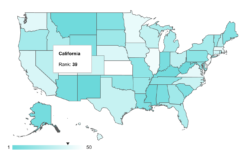A Brief History of Your New Lifelong Passion: The Salsa
By J. Altaverde
08/15/2021
As L.A. emerges from the pandemic and months of isolation, I’ve heard many folks, both friends and casual acquaintances, express a desire for a life filled with something a little more meaningful, something more soulful and connective, something with a little more…pizazz than zoom meetings in pajamas. I’ve heard of many folks who wish to take up something new, and who have made “post-covid resolutions” to learn to Salsa Dance.
For many who have yet to venture out onto the dancefloor, the idea of the salsa conjures images of sweaty bodies, lush music, passionate exchanges between dance partners. Many casually assume that salsa is a spinoff of American ballroom, just one slightly saucier step away from the foxtrot or a waltz. If you, too, long to feel the exuberance of the salsa, it’s a good idea to learn a bit more about the dance and its amazing origins, going back by way of the Caribbean into its African Roots. The more you know, the more you can fully enjoy not only the natural joy of the dance and the music, but become a better dancer as you go on a journey into the culture and meaning of all the sound, rhythms, and movement.
So what is Salsa, really?
Salsa can be a blanket term that describes both a style of dance music and the dance itself, that comes out of Latin America and the Caribbean. Many beginners mistakenly assume everything rhythmic they hear in Spanish or at a club is called, or considered Salsa, but that is not the case, and it’s important to learn the differences in what you are hearing and what dances people are doing.
More specifically, Salsa refers to a specific style of music and dance that is a Cuban-influenced genre created in New York City in the 1960s. Its origins are rooted in a style of music from Eastern Cuba called Son Cubano, an Afro-Cuban style of music created by Cuban musicians of Bantu descent, combining traditional African rhythms with European musical traditions. The Bantu people, as well as people from other ethnic groups from Western and Central Africa, were brought to Cuba, Puerto Rico, the Caribbean, and the US as slaves during the slave trade, and they brought with them their traditional rhythms, languages, religious beliefs and cultural practices, many of which have survived to this day both in Africa and the Americas.
Salsa as its own genre took form in the US, and while it draws its roots from Son Cubano, early salsa musicians also incorporated elements of other Cuban forms, including danzon, rumba, guaracha, cha-cha-cha, mambo, son montuno, and Latin jazz. Many of the early salsa musicians in the U.S. were Puerto Rican, and they incorporated additional Puerto Rican traditional forms such as plena and bomba into the music. Other prominent Salsa musicians hailed from countries including Venezuela, Colombia, and other Latin American Countries. With its incredible mix of influences, it is no wonder that “Salsa” means “the sauce”!
Early bandleaders and singers from the ’60s and 70’s- whose names and music you will quickly begin to hear regularly in Salsa clubs and on dancefloors- include Tito Puente, the Cuban-born Celia Cruz, Hector Lavoe, Ray Baretto, and Johnny Pacheco. In the 1960s, Pacheco’s label Fania Records, and the collective of performers called the Fania All-Stars, released many of the top recordings and thus began the popularization of the genre and the spread of salsa across the US and back into Latin America and the Caribbean.
Salsa, however, is not a stagnant genre, stuck in its golden days of the ’60s and ’70s. It has evolved as its own genre over time, with cutting edge creativity, and also inspired various forms of pop, Latin jazz, and hip hop. Timba is a present-day, thriving musical genre that combines Salsa, funk, and R&B. While one technically still dances salsa steps, and the rhythms are similar, Timba has its own following within the Salsa world, and differences in dance style, often incorporating Afro-Cuban traditional forms, contemporary hip hop styles, and explosive improvisation. Other contemporary styles within Salsa also include what is known as New York Style/”On 2”, and Los Angeles style salsas.
In some salsa clubs, Salsa and Timba may be the main fare, but to break it up and give dancers a rest or change of tempo, DJ’s and live bands may include several other music styles, each with their own rhythms, dances, and unique cultural origins, including merengue, bachata, cumbia, and reggaeton. If you are new to the dancefloor, be observant when you hear the rhythm and change and the dancers shift into different steps, and ask some friendly folks about those dances. You’ll be off on another historical journey into Latin America and back. So many dances to learn….so little time!

